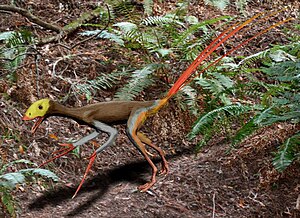Epidexipteryx
| Epidexipteryx | ||||||||||||
|---|---|---|---|---|---|---|---|---|---|---|---|---|

Epidexipteryx hui |
||||||||||||
| Temporal occurrence | ||||||||||||
| Bathonian to Kimmeridgian ( Jura ) | ||||||||||||
| 168.3 to 152.1 million years | ||||||||||||
| Locations | ||||||||||||
| Systematics | ||||||||||||
|
||||||||||||
| Scientific name | ||||||||||||
| Epidexipteryx | ||||||||||||
| Zhang et al., 2008 |
Epidexipteryx is a genus of small theropod dinosaurs from the Middle Jurassic or Upper Jurassic (between 167 and 151 million years ago) of China .
Only the type species E. hui has been scientifically described . The generic name consists of the Greek words epidexi "display" and pteryx - "wing", "feather". The art epithet hui honors the Chinese paleontologist Yaoming Hu .
The fossil remains of the holotype were found in the Daohugou strata in Inner Mongolia and scientifically described in 2008. The genus is cladistically placed as a sister taxon of Epidendrosaurus in the Scansoriopterygidae at the base of the Avialae .
features
Epidexipteryx was about the size of a pigeon with an estimated body weight of 164 grams. The animal was feathered and had four conspicuously elongated, ribbon-like feathers on its relatively short tail. It is believed that these feathers served a display function, possibly during courtship . Contour feathers are missing, so that Epidexipteryx was certainly not able to fly.
The enlarged front teeth in the tall skull pointed forward, an unusual arrangement that was otherwise only found in Masiakasaurus within the Theropoda .
The type specimen is kept in the Institute of Vertebrate Paleontology and Paleoanthropology of the Chinese Academy of Sciences under the collection number IVPP V15471.
literature
- Fucheng Zhang, Zhonghe Zhou , Xing Xu , Xiaolin Wang, Corwin Sullivan: A bizarre Jurassic maniraptoran from China with elongate ribbon-like feathers. In: Nature . Vol. 455, No. 7216, 2008, pp. 1105-1108, doi : 10.1038 / nature07447 .